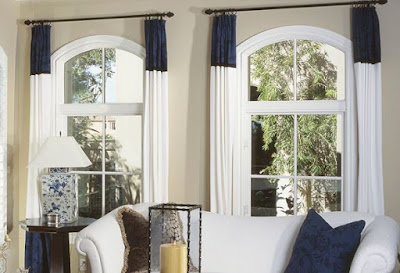DECORATIVE PANELS
Sometimes, the only reason to hang drapes is to add a final design element to a beautiful room, like adding jewelry to the perfect outfit.
One Width Decorative Panels
You may have a stunning view that you want to frame. Or maybe you would like to soften the windows, add some color and texture, or just showcase a gorgeous fabric. Whatever the reason, sizing your decorative panels correctly is key.
The Regal Drapes design tool makes sizing stationary drapes easy. Once you have decided on the amount of wall space you would like to cover on either side of your window, enter this dimension into the design tool as the "rod width" and the correct finished width will be calculated. We suggest from 18-30 inches, depending on the size and scale of your windows.
One Width Grommet Panels
To help you determine the optimal rod size and placement, here are a few tips. If you are going to use two short rods, start measuring about 1-2 inches over the window glass from the trim side. The edge of the panel should only cover a small amount of the actual window. From this point, work back away from the glass towards the wall and determine the amount of space you would like the drapes to cover. Let's say you want 14 inches of wall to be covered with drapery. Add 14 plus the two inches on the glass, plus the width of any trim. In this example we will assume two inch trim. The rod width would be 14+2+2 or 18 inches. Be sure to account for the size of your finials, especially if the window edge is close to an adjacent wall. The finials will take up additional wall space. This formula will work for any drapery style; flat panels, grommets or pleated drapes.
If you prefer the look of a single rod across the window, you will still need to decide the amount of wall space the drapes will cover and add that number to your overall window width. If you would like the drapes to stack to 18 inches per side, start about 1-2 inches over the window glass and measure back to 18 inches. After measuring the window width from trim to trim, include the extra space you measured. Start 2 inches over glass + 3 inches of trim. This will result in 5 of the 18 inches you want to cover, so the remainder of 13 inches is the additional rod width that will extend past the window trim. For a 60 inch window, the total rod would be 60+13+13= 86 inches.
Inverted Pleats with Single Rods
To really maximize the beauty of decorative drapes, it is important to understand the way custom fabric is received in the workroom. A bolt of fabric usually measures between 48-54 inches wide. After selvage and side hems, a non-pleated drape will have a finished width of about 50 inches using one width of fabric.
When making a pair of drapes, a single width can be added to each panel by joining half a width to each one. This results in a panel that is 1.5 widths wide. A Regal Drapes Design Consultant can help you maximize the fullness by assuring you are getting the most out of each fabric width. Our Design Team wants to be sure your custom drapes will use every available inch of fabric to be as full as possible.
Decorative Panels with a Puddle
For very narrow windows, you will be able to dress them with a single width; about 50 inches for non-pleated styles and about 22 inches for pleated drapes. Larger windows may need up to 2 to 2.5 widths to be in proportion. A Regal Drapes Design Consultant is available to customize decorative panels for your unique window design.
Two Story Pleated Panels








